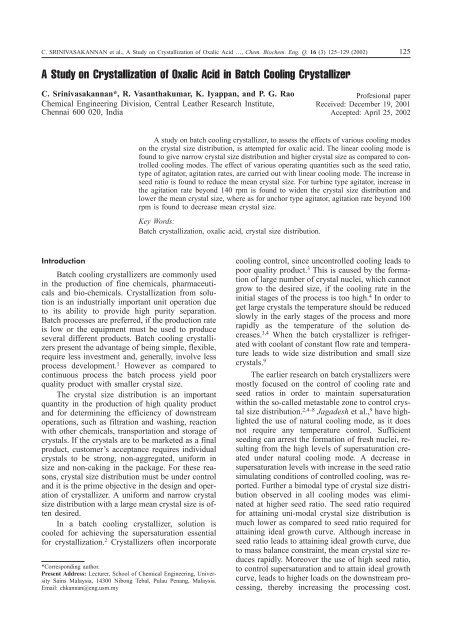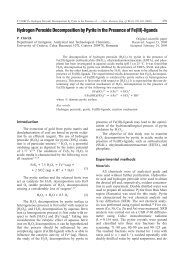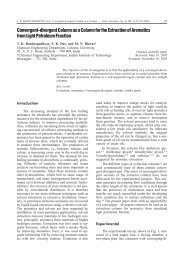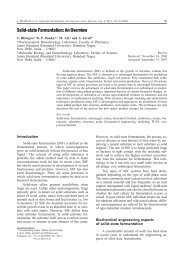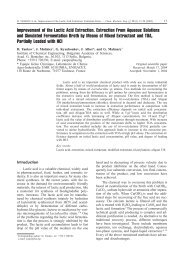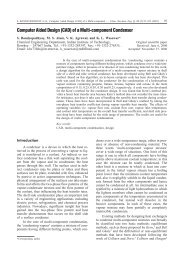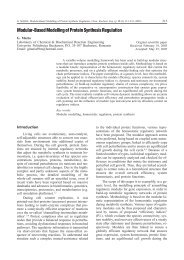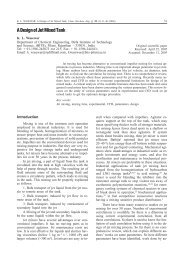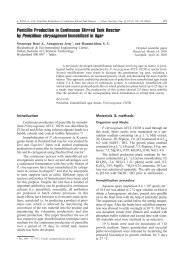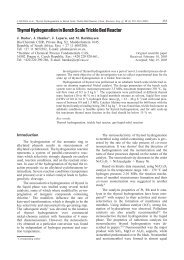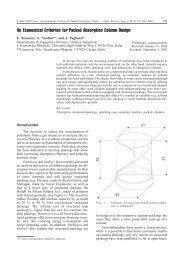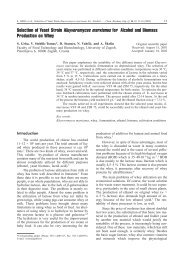A Study on Crystallization of Oxalic Acid in Batch Cooling ... - pierre
A Study on Crystallization of Oxalic Acid in Batch Cooling ... - pierre
A Study on Crystallization of Oxalic Acid in Batch Cooling ... - pierre
You also want an ePaper? Increase the reach of your titles
YUMPU automatically turns print PDFs into web optimized ePapers that Google loves.
C. SRINIVASAKANNAN et al., A <str<strong>on</strong>g>Study</str<strong>on</strong>g> <strong>on</strong> Crystallizati<strong>on</strong> <strong>of</strong> <strong>Oxalic</strong> <strong>Acid</strong> …, Chem. Biochem. Eng. Q. 16 (3) 125–129 (2002) 125<br />
A <str<strong>on</strong>g>Study</str<strong>on</strong>g> <strong>on</strong> Crystallizati<strong>on</strong> <strong>of</strong> <strong>Oxalic</strong> <strong>Acid</strong> <strong>in</strong> <strong>Batch</strong> Cool<strong>in</strong>g Crystallizer<br />
C. Sr<strong>in</strong>ivasakannan*, R. Vasanthakumar, K. Iyappan, and P. G. Rao<br />
Chemical Eng<strong>in</strong>eer<strong>in</strong>g Divisi<strong>on</strong>, Central Leather Research Institute,<br />
Chennai 600 020, India<br />
Pr<strong>of</strong>esi<strong>on</strong>al paper<br />
Received: December 19, 2001<br />
Accepted: April 25, 2002<br />
A study <strong>on</strong> batch cool<strong>in</strong>g crystallizer, to assess the effects <strong>of</strong> various cool<strong>in</strong>g modes<br />
<strong>on</strong> the crystal size distributi<strong>on</strong>, is attempted for oxalic acid. The l<strong>in</strong>ear cool<strong>in</strong>g mode is<br />
found to give narrow crystal size distributi<strong>on</strong> and higher crystal size as compared to c<strong>on</strong>trolled<br />
cool<strong>in</strong>g modes. The effect <strong>of</strong> various operat<strong>in</strong>g quantities such as the seed ratio,<br />
type <strong>of</strong> agitator, agitati<strong>on</strong> rates, are carried out with l<strong>in</strong>ear cool<strong>in</strong>g mode. The <strong>in</strong>crease <strong>in</strong><br />
seed ratio is found to reduce the mean crystal size. For turb<strong>in</strong>e type agitator, <strong>in</strong>crease <strong>in</strong><br />
the agitati<strong>on</strong> rate bey<strong>on</strong>d 140 rpm is found to widen the crystal size distributi<strong>on</strong> and<br />
lower the mean crystal size, where as for anchor type agitator, agitati<strong>on</strong> rate bey<strong>on</strong>d 100<br />
rpm is found to decrease mean crystal size.<br />
Key Words:<br />
<strong>Batch</strong> crystallizati<strong>on</strong>, oxalic acid, crystal size distributi<strong>on</strong>.<br />
Introducti<strong>on</strong><br />
<strong>Batch</strong> cool<strong>in</strong>g crystallizers are comm<strong>on</strong>ly used<br />
<strong>in</strong> the producti<strong>on</strong> <strong>of</strong> f<strong>in</strong>e chemicals, pharmaceuticals<br />
and bio-chemicals. Crystallizati<strong>on</strong> from soluti<strong>on</strong><br />
is an <strong>in</strong>dustrially important unit operati<strong>on</strong> due<br />
to its ability to provide high purity separati<strong>on</strong>.<br />
<strong>Batch</strong> processes are preferred, if the producti<strong>on</strong> rate<br />
is low or the equipment must be used to produce<br />
several different products. <strong>Batch</strong> cool<strong>in</strong>g crystallizers<br />
present the advantage <strong>of</strong> be<strong>in</strong>g simple, flexible,<br />
require less <strong>in</strong>vestment and, generally, <strong>in</strong>volve less<br />
process development. 1 However as compared to<br />
c<strong>on</strong>t<strong>in</strong>uous process the batch process yield poor<br />
quality product with smaller crystal size.<br />
The crystal size distributi<strong>on</strong> is an important<br />
quantity <strong>in</strong> the producti<strong>on</strong> <strong>of</strong> high quality product<br />
and for determ<strong>in</strong><strong>in</strong>g the efficiency <strong>of</strong> downstream<br />
operati<strong>on</strong>s, such as filtrati<strong>on</strong> and wash<strong>in</strong>g, reacti<strong>on</strong><br />
with other chemicals, transportati<strong>on</strong> and storage <strong>of</strong><br />
crystals. If the crystals are to be marketed as a f<strong>in</strong>al<br />
product, customer’s acceptance requires <strong>in</strong>dividual<br />
crystals to be str<strong>on</strong>g, n<strong>on</strong>-aggregated, uniform <strong>in</strong><br />
size and n<strong>on</strong>-cak<strong>in</strong>g <strong>in</strong> the package. For these reas<strong>on</strong>s,<br />
crystal size distributi<strong>on</strong> must be under c<strong>on</strong>trol<br />
and it is the prime objective <strong>in</strong> the design and operati<strong>on</strong><br />
<strong>of</strong> crystallizer. A uniform and narrow crystal<br />
size distributi<strong>on</strong> with a large mean crystal size is <strong>of</strong>ten<br />
desired.<br />
In a batch cool<strong>in</strong>g crystallizer, soluti<strong>on</strong> is<br />
cooled for achiev<strong>in</strong>g the supersaturati<strong>on</strong> essential<br />
for crystallizati<strong>on</strong>. 2 Crystallizers <strong>of</strong>ten <strong>in</strong>corporate<br />
*Corresp<strong>on</strong>d<strong>in</strong>g author.<br />
Present Address: Lecturer, School <strong>of</strong> Chemical Eng<strong>in</strong>eer<strong>in</strong>g, University<br />
Sa<strong>in</strong>s Malaysia, 14300 Nib<strong>on</strong>g Tebal, Pulau Penang, Malaysia.<br />
Email: chkannan@eng.usm.my<br />
cool<strong>in</strong>g c<strong>on</strong>trol, s<strong>in</strong>ce unc<strong>on</strong>trolled cool<strong>in</strong>g leads to<br />
poor quality product. 3 This is caused by the formati<strong>on</strong><br />
<strong>of</strong> large number <strong>of</strong> crystal nuclei, which cannot<br />
grow to the desired size, if the cool<strong>in</strong>g rate <strong>in</strong> the<br />
<strong>in</strong>itial stages <strong>of</strong> the process is too high. 4 In order to<br />
get large crystals the temperature should be reduced<br />
slowly <strong>in</strong> the early stages <strong>of</strong> the process and more<br />
rapidly as the temperature <strong>of</strong> the soluti<strong>on</strong> decreases.<br />
3,4 When the batch crystallizer is refrigerated<br />
with coolant <strong>of</strong> c<strong>on</strong>stant flow rate and temperature<br />
leads to wide size distributi<strong>on</strong> and small size<br />
crystals. 9<br />
The earlier research <strong>on</strong> batch crystallizers were<br />
mostly focused <strong>on</strong> the c<strong>on</strong>trol <strong>of</strong> cool<strong>in</strong>g rate and<br />
seed ratios <strong>in</strong> order to ma<strong>in</strong>ta<strong>in</strong> supersaturati<strong>on</strong><br />
with<strong>in</strong> the so-called metastable z<strong>on</strong>e to c<strong>on</strong>trol crystal<br />
size distributi<strong>on</strong>. 2,4–8 Jagadesh et al., 9 have highlighted<br />
the use <strong>of</strong> natural cool<strong>in</strong>g mode, as it does<br />
not require any temperature c<strong>on</strong>trol. Sufficient<br />
seed<strong>in</strong>g can arrest the formati<strong>on</strong> <strong>of</strong> fresh nuclei, result<strong>in</strong>g<br />
from the high levels <strong>of</strong> supersaturati<strong>on</strong> created<br />
under natural cool<strong>in</strong>g mode. A decrease <strong>in</strong><br />
supersaturati<strong>on</strong> levels with <strong>in</strong>crease <strong>in</strong> the seed ratio<br />
simulat<strong>in</strong>g c<strong>on</strong>diti<strong>on</strong>s <strong>of</strong> c<strong>on</strong>trolled cool<strong>in</strong>g, was reported.<br />
Further a bimodal type <strong>of</strong> crystal size distributi<strong>on</strong><br />
observed <strong>in</strong> all cool<strong>in</strong>g modes was elim<strong>in</strong>ated<br />
at higher seed ratio. The seed ratio required<br />
for atta<strong>in</strong><strong>in</strong>g uni-modal crystal size distributi<strong>on</strong> is<br />
much lower as compared to seed ratio required for<br />
atta<strong>in</strong><strong>in</strong>g ideal growth curve. Although <strong>in</strong>crease <strong>in</strong><br />
seed ratio leads to atta<strong>in</strong><strong>in</strong>g ideal growth curve, due<br />
to mass balance c<strong>on</strong>stra<strong>in</strong>t, the mean crystal size reduces<br />
rapidly. Moreover the use <strong>of</strong> high seed ratio,<br />
to c<strong>on</strong>trol supersaturati<strong>on</strong> and to atta<strong>in</strong> ideal growth<br />
curve, leads to higher loads <strong>on</strong> the downstream process<strong>in</strong>g,<br />
thereby <strong>in</strong>creas<strong>in</strong>g the process<strong>in</strong>g cost.
126 C. SRINIVASAKANNAN et al., A <str<strong>on</strong>g>Study</str<strong>on</strong>g> <strong>on</strong> Crystallizati<strong>on</strong> <strong>of</strong> <strong>Oxalic</strong> <strong>Acid</strong> …, Chem. Biochem. Eng. Q. 16 (3) 125–129 (2002)<br />
S<strong>in</strong>ce the c<strong>on</strong>trol <strong>of</strong> cool<strong>in</strong>g rate is quite easy with<br />
use <strong>of</strong> modern process c<strong>on</strong>trol, the present study attempts<br />
to study the effect <strong>of</strong> different cool<strong>in</strong>g<br />
modes <strong>on</strong> crystal size distributi<strong>on</strong> for a uni-modal<br />
crystal size distributi<strong>on</strong> <strong>of</strong> oxalic acid. The effects<br />
<strong>of</strong> various operat<strong>in</strong>g quantities <strong>on</strong> crystal size distributi<strong>on</strong><br />
for the best identified cool<strong>in</strong>g mode, has<br />
been studied.<br />
Experimental<br />
Experiments are carried out <strong>in</strong> a five liter jacketed<br />
crystallizer made <strong>of</strong> sta<strong>in</strong>less steel 316 Grade,<br />
with mild steel jacket for heat<strong>in</strong>g and cool<strong>in</strong>g purpose.<br />
The schematic diagram <strong>of</strong> the experimental<br />
set up is shown <strong>in</strong> Figure 1. The crystallizer c<strong>on</strong>sists<br />
<strong>of</strong> agitator (1), baffles (2), jacket (3), jacket<br />
fluid <strong>in</strong>let (4), jacket fluid outlet (5), and outlet<br />
valve (6). The diameter <strong>of</strong> the crystallizer is 180<br />
mm with a height <strong>of</strong> 240 mm. The experimental set<br />
up comprises <strong>of</strong> a circulati<strong>on</strong> bath with provisi<strong>on</strong> to<br />
either cool to –50 °C or heat to 250 °C. Six blade<br />
pitched turb<strong>in</strong>e and anchor agitators are used <strong>in</strong> the<br />
present study. The agitator is placed 20 mm from<br />
the bottom <strong>of</strong> the crystallizer. The diameter <strong>of</strong> turb<strong>in</strong>e<br />
as well as anchor agitator is 90 mm. Two baffles<br />
<strong>of</strong> 23 mm are <strong>in</strong>stalled opposite to each other to<br />
avoid vortex formati<strong>on</strong> and for better mix<strong>in</strong>g <strong>on</strong>ly<br />
<strong>in</strong> the case <strong>of</strong> turb<strong>in</strong>e agitator.<br />
<strong>in</strong> the c<strong>on</strong>trol unit refers to the temperature <strong>in</strong> the<br />
crystallizer bath and accord<strong>in</strong>gly manipulates the<br />
temperature <strong>of</strong> coolant to achieve the required temperature.<br />
Based <strong>on</strong> the solubility data (Table.1) a<br />
saturated soluti<strong>on</strong> <strong>of</strong> oxalic acid is prepared at a<br />
temperature <strong>of</strong> 60 °C by dissolv<strong>in</strong>g required amount<br />
<strong>of</strong> oxalic acid <strong>in</strong> three liters <strong>of</strong> distilled water. After<br />
dissolv<strong>in</strong>g the stirrer speed is adjusted to the desired<br />
level. The experiments are started by cool<strong>in</strong>g the<br />
soluti<strong>on</strong> at different cool<strong>in</strong>g rates as required for the<br />
experiment. The seeds are added to the crystallizer<br />
under supersaturated c<strong>on</strong>diti<strong>on</strong>s at required seed ratio.<br />
Seed ratio is def<strong>in</strong>ed as the mass <strong>of</strong> seeds taken<br />
to the theoretical yield <strong>of</strong> crystals taken from solubility<br />
curve by cool<strong>in</strong>g from 60 to 10 °C. Prelim<strong>in</strong>ary<br />
experiments are c<strong>on</strong>ducted to ensure that<br />
uni-modal crystal size distributi<strong>on</strong> is obta<strong>in</strong>ed at<br />
the seed ratio used <strong>in</strong> the present study. The total<br />
suspensi<strong>on</strong> is withdrawn at the end <strong>of</strong> the experiment,<br />
filtered <strong>in</strong> a Buckner funnel under vacuum.<br />
The product is dried <strong>in</strong> an air oven and subjected to<br />
sieve analysis. The crystal size distributi<strong>on</strong> is obta<strong>in</strong>ed<br />
and the mean size is calculated. The experiments<br />
are c<strong>on</strong>ducted cover<strong>in</strong>g different temperature<br />
pr<strong>of</strong>iles as shown <strong>in</strong> Figure 2. The details <strong>of</strong> various<br />
quantities covered <strong>in</strong> the present study are detailed<br />
<strong>in</strong> Table 2.<br />
Table 1<br />
Solubility Data for <strong>Oxalic</strong> <strong>Acid</strong> – Water System<br />
Temperature °C g <strong>of</strong> oxalic acid / 100 g <strong>of</strong> water<br />
0 3.0<br />
10 6.0<br />
20 9.5<br />
30 14.5<br />
40 21.6<br />
60 44.3<br />
80 84.4<br />
Table 2<br />
Details <strong>of</strong> qualitities and their range covered <strong>in</strong><br />
the present study<br />
Quantities Range Unit<br />
Fig. 1<br />
Schematic diagram <strong>of</strong> experimental setup<br />
(1) Agitator, (2) Baffles, (3) Jacket, (4) Jacket<br />
fluid <strong>in</strong>let, (5) Jacket fluid outlet, (6) Outlet valve.<br />
Desired temperature <strong>in</strong> the crystallizer is<br />
achieved by sett<strong>in</strong>g appropriate temperature <strong>in</strong> the<br />
c<strong>on</strong>trol unit <strong>of</strong> circulati<strong>on</strong> bath. Temperature sensor<br />
Type <strong>of</strong> Agitators<br />
Six Blade turb<strong>in</strong>e,<br />
Anchor<br />
Temperature 60 to 10 °C<br />
Seed Ratio 1, 3<br />
<strong>Batch</strong> time 130, 300 m<strong>in</strong>.<br />
Agitator speed 100, 140, 180 rpm<br />
Seed size 80 m
C. SRINIVASAKANNAN et al., A <str<strong>on</strong>g>Study</str<strong>on</strong>g> <strong>on</strong> Crystallizati<strong>on</strong> <strong>of</strong> <strong>Oxalic</strong> <strong>Acid</strong> …, Chem. Biochem. Eng. Q. 16 (3) 125–129 (2002) 127<br />
Results and discussi<strong>on</strong><br />
In order to assess the crystallizati<strong>on</strong> characteristics<br />
<strong>of</strong> crystallizer, experiments are carried out<br />
with l<strong>in</strong>ear cool<strong>in</strong>g mode and different c<strong>on</strong>trolled<br />
cool<strong>in</strong>g modes. The effect <strong>of</strong> operat<strong>in</strong>g quantities<br />
such as agitati<strong>on</strong> rates, type <strong>of</strong> agitator and seed ratio,<br />
are performed for the best identified cool<strong>in</strong>g<br />
mode.<br />
Figure 2 shows different cool<strong>in</strong>g modes adopted<br />
for experimentati<strong>on</strong>. Curve c<strong>on</strong>trolled cool<strong>in</strong>g<br />
mode A, corresp<strong>on</strong>ds to slower cool<strong>in</strong>g rate dur<strong>in</strong>g<br />
the <strong>in</strong>itial stages and faster cool<strong>in</strong>g <strong>in</strong> the later<br />
stages. Curve c<strong>on</strong>trolled cool<strong>in</strong>g mode B corresp<strong>on</strong>ds<br />
to faster cool<strong>in</strong>g rate dur<strong>in</strong>g the <strong>in</strong>itial stages<br />
and slower cool<strong>in</strong>g dur<strong>in</strong>g the later stages. Curve<br />
l<strong>in</strong>ear cool<strong>in</strong>g mode corresp<strong>on</strong>ds to c<strong>on</strong>stant rate <strong>of</strong><br />
cool<strong>in</strong>g from the beg<strong>in</strong>n<strong>in</strong>g to end. However all the<br />
experiments are carried out for 300 m<strong>in</strong>utes. Curve<br />
c<strong>on</strong>trolled cool<strong>in</strong>g mode C corresp<strong>on</strong>ds to the case<br />
<strong>in</strong> which f<strong>in</strong>al temperature <strong>of</strong> the magma is reached<br />
at much faster rate as compared to other cool<strong>in</strong>g<br />
modes. The f<strong>in</strong>al temperature <strong>of</strong> 10 °C is atta<strong>in</strong>ed<br />
with <strong>in</strong> 130 m<strong>in</strong>utes.<br />
Fig. 2<br />
Plot <strong>of</strong> crystallizer temperature with respect to<br />
time observed for various cool<strong>in</strong>g modes<br />
The different temperature pr<strong>of</strong>iles corresp<strong>on</strong>d<br />
to different levels <strong>of</strong> supersaturati<strong>on</strong> dur<strong>in</strong>g various<br />
stages <strong>of</strong> crystallizati<strong>on</strong>. Figure 3 compares the<br />
crystal size distributi<strong>on</strong> <strong>of</strong> all the above different<br />
modes <strong>of</strong> cool<strong>in</strong>g. It can be observed, that a narrow<br />
crystal size distributi<strong>on</strong> and higher mean size is obta<strong>in</strong>ed<br />
for l<strong>in</strong>ear cool<strong>in</strong>g mode, as compared to c<strong>on</strong>trolled<br />
cool<strong>in</strong>g mode A. This is c<strong>on</strong>trary to the belief,<br />
as the supersaturati<strong>on</strong> levels are ma<strong>in</strong>ta<strong>in</strong>ed<br />
lower dur<strong>in</strong>g the <strong>in</strong>itial stages <strong>in</strong> c<strong>on</strong>trolled cool<strong>in</strong>g<br />
mode A, as compared to l<strong>in</strong>ear cool<strong>in</strong>g mode. This<br />
may be due to the sec<strong>on</strong>dary nucleati<strong>on</strong>, which sets<br />
<strong>in</strong> at later stages <strong>of</strong> cool<strong>in</strong>g due to higher levels <strong>of</strong><br />
supersaturati<strong>on</strong>, has lesser time to grow result<strong>in</strong>g <strong>in</strong><br />
Fig. 3<br />
Effect <strong>of</strong> different cool<strong>in</strong>g modes <strong>on</strong> crystal size<br />
distributi<strong>on</strong><br />
wider crystal size distributi<strong>on</strong> and lower mean size.<br />
On the other hand <strong>in</strong> the case <strong>of</strong> l<strong>in</strong>ear cool<strong>in</strong>g<br />
mode the small amount <strong>of</strong> nucleati<strong>on</strong> that sets <strong>in</strong><br />
dur<strong>in</strong>g the <strong>in</strong>itial stages <strong>of</strong> cool<strong>in</strong>g has ample time<br />
to grow result<strong>in</strong>g <strong>in</strong> a narrow size distributi<strong>on</strong> and<br />
higher mean size.<br />
The crystal size distributi<strong>on</strong> due to c<strong>on</strong>trolled<br />
cool<strong>in</strong>g mode B is <strong>in</strong>ferior to the l<strong>in</strong>ear cool<strong>in</strong>g<br />
mode and c<strong>on</strong>trolled cool<strong>in</strong>g mode A (Fig. 3). This<br />
may be due to high levels <strong>of</strong> supersaturati<strong>on</strong> <strong>in</strong> the<br />
<strong>in</strong>itial stages, which leads to higher <strong>in</strong>itial nucleati<strong>on</strong>,<br />
lead<strong>in</strong>g to lower mean crystal size and wider<br />
crystal size distributi<strong>on</strong>.<br />
It can be observed from Figure 3 that the crystal<br />
size distributi<strong>on</strong> due to c<strong>on</strong>trolled cool<strong>in</strong>g mode<br />
C is <strong>in</strong>ferior as compared to other cool<strong>in</strong>g modes.<br />
S<strong>in</strong>ce the rate <strong>of</strong> cool<strong>in</strong>g <strong>in</strong> c<strong>on</strong>trolled cool<strong>in</strong>g mode<br />
C, as compared to other cool<strong>in</strong>g modes is much<br />
faster lead<strong>in</strong>g to exposure <strong>of</strong> the seeded crystal to<br />
much higher levels <strong>of</strong> supersaturati<strong>on</strong>, results <strong>in</strong><br />
high amounts <strong>of</strong> <strong>in</strong>itial nucleati<strong>on</strong> and leads to<br />
wider size distributi<strong>on</strong> and low mean crystal size.<br />
The effects <strong>of</strong> operat<strong>in</strong>g quantities such as the<br />
seed ratio, type <strong>of</strong> agitator, agitati<strong>on</strong> rate, are carried<br />
out follow<strong>in</strong>g l<strong>in</strong>ear cool<strong>in</strong>g mode with 300<br />
m<strong>in</strong>utes crystallizati<strong>on</strong> durati<strong>on</strong>.<br />
Figure 4 shows a reducti<strong>on</strong> <strong>in</strong> the mean crystal<br />
size with the <strong>in</strong>crease <strong>in</strong> seed ratio, although, there<br />
is no significant change <strong>in</strong> the crystal size distributi<strong>on</strong>.<br />
The reducti<strong>on</strong> <strong>in</strong> mean size <strong>of</strong> the crystals is<br />
due to the mass balance c<strong>on</strong>stra<strong>in</strong>t. With the <strong>in</strong>crease<br />
<strong>in</strong> number <strong>of</strong> seed crystals, the solute is distributed<br />
<strong>on</strong> higher number <strong>of</strong> seeds, and hence the<br />
size <strong>in</strong>crease is limited. The <strong>in</strong>crease <strong>in</strong> seed ratio<br />
<strong>on</strong> <strong>on</strong>e hand reduces the <strong>in</strong>itial nucleati<strong>on</strong> <strong>in</strong> l<strong>in</strong>ear<br />
cool<strong>in</strong>g pr<strong>of</strong>ile and <strong>on</strong> the other hand promotes<br />
growth <strong>of</strong> the seeded crystals, <strong>on</strong> the other hand due<br />
to mass balance c<strong>on</strong>stra<strong>in</strong>ts the size enlargement is<br />
limited.
128 C. SRINIVASAKANNAN et al., A <str<strong>on</strong>g>Study</str<strong>on</strong>g> <strong>on</strong> Crystallizati<strong>on</strong> <strong>of</strong> <strong>Oxalic</strong> <strong>Acid</strong> …, Chem. Biochem. Eng. Q. 16 (3) 125–129 (2002)<br />
Fig. 4<br />
Effect <strong>of</strong> seed c<strong>on</strong>centrati<strong>on</strong> <strong>on</strong> crystal size distributi<strong>on</strong><br />
Figure 5 compares the crystal size distributi<strong>on</strong><br />
for turb<strong>in</strong>e agitator and anchor agitator at 140 rpm.<br />
A higher mean crystal size and narrow crystal size<br />
distributi<strong>on</strong> is obta<strong>in</strong>ed for turb<strong>in</strong>e type agitator as<br />
compared to anchor type agitator. It could be, because<br />
<strong>of</strong> the <strong>in</strong>tense mix<strong>in</strong>g <strong>in</strong> anchor agitator, as<br />
compared to turb<strong>in</strong>e agitator lead<strong>in</strong>g to formati<strong>on</strong> <strong>of</strong><br />
sec<strong>on</strong>dary nucleati<strong>on</strong> due to attriti<strong>on</strong>, c<strong>on</strong>tribut<strong>in</strong>g<br />
to fresh nuclei, results <strong>in</strong> lower mean size and wider<br />
crystal size distributi<strong>on</strong>.<br />
Fig. 6<br />
Effect <strong>of</strong> different Agitati<strong>on</strong> rate with turb<strong>in</strong>e agitator<br />
<strong>on</strong> crystal size distributi<strong>on</strong><br />
Fig. 7<br />
Effect <strong>of</strong> different Agitati<strong>on</strong> rate with Anchor agitator<br />
<strong>on</strong> crystal size distributi<strong>on</strong><br />
agitator, 100 rpm is sufficient to keep the solids <strong>in</strong><br />
suspensi<strong>on</strong> without aid<strong>in</strong>g formati<strong>on</strong> <strong>of</strong> fresh nuclei<br />
due to attriti<strong>on</strong>.<br />
Fig. 5<br />
Effect <strong>of</strong> type <strong>of</strong> Agitator <strong>on</strong> crystal size distributi<strong>on</strong><br />
It can be evidenced from figure 6 that a higher<br />
mean crystal size and narrow crystal size distributi<strong>on</strong><br />
is obta<strong>in</strong>ed at 140 rpm as compared to 180 rpm<br />
with turb<strong>in</strong>e type agitator. At 180 rpm the mix<strong>in</strong>g is<br />
more <strong>in</strong>tense lead<strong>in</strong>g to formati<strong>on</strong> <strong>of</strong> fresh nucleati<strong>on</strong><br />
due to attriti<strong>on</strong> result<strong>in</strong>g <strong>in</strong> poorer product<br />
quality. Similarly figure 7 shows a higher mean<br />
crystal size at 100 rpm as compared to 140 rpm for<br />
anchor agitator. In the case <strong>of</strong> anchor agitator s<strong>in</strong>ce<br />
the mix<strong>in</strong>g is observed to be better than the turb<strong>in</strong>e<br />
C<strong>on</strong>clusi<strong>on</strong>s<br />
A detailed study <strong>in</strong> batch cool<strong>in</strong>g crystallizer<br />
cover<strong>in</strong>g different cool<strong>in</strong>g modes is carried out and<br />
it is found that a l<strong>in</strong>ear temperature pr<strong>of</strong>ile with 300<br />
m<strong>in</strong>utes cool<strong>in</strong>g cycle is found to provide narrow<br />
crystal size distributi<strong>on</strong> and higher mean crystal<br />
size. The effects <strong>of</strong> various quantities such as the<br />
seed ratio, type <strong>of</strong> agitator, agitati<strong>on</strong> rate are assessed<br />
under l<strong>in</strong>ear cool<strong>in</strong>g mode. The <strong>in</strong>crease <strong>in</strong><br />
seed ratio is found to decrease the mean crystal size<br />
due to mass balance c<strong>on</strong>stra<strong>in</strong>ts. The turb<strong>in</strong>e agitator<br />
is found to have narrow crystal size distributi<strong>on</strong><br />
and higher mean crystal size at 140 rpm as com-
C. SRINIVASAKANNAN et al., A <str<strong>on</strong>g>Study</str<strong>on</strong>g> <strong>on</strong> Crystallizati<strong>on</strong> <strong>of</strong> <strong>Oxalic</strong> <strong>Acid</strong> …, Chem. Biochem. Eng. Q. 16 (3) 125–129 (2002) 129<br />
pared to anchor agitator. This is attributed to the <strong>in</strong>tense<br />
mix<strong>in</strong>g with anchor agitator, which leads to<br />
sec<strong>on</strong>dary nucleati<strong>on</strong> due to attriti<strong>on</strong>. Similarly 140<br />
rpm is found to give higher mean size and narrow<br />
size distributi<strong>on</strong> as compared to 180 rpm with turb<strong>in</strong>e<br />
agitator. With anchor agitator 100 rpm is found<br />
to give higher mean crystal size as compared to 140<br />
rpm. An agitati<strong>on</strong> rate <strong>of</strong> 100 rpm is sufficient to<br />
keep the solids <strong>in</strong> suspensi<strong>on</strong> with anchor agitator,<br />
whereas 140 rpm is required <strong>in</strong> the case <strong>of</strong> turb<strong>in</strong>e<br />
agitator.<br />
List <strong>of</strong> Symbols<br />
SR<br />
m<br />
m s<br />
m th<br />
– Seed Ratio, m s /m th<br />
– mass <strong>of</strong> crystal<br />
– mass <strong>of</strong> sead crystals<br />
– theoretical mass <strong>of</strong> crystal<br />
d c – crystal diameter, m<br />
t – time, h<br />
T – temperature, °C<br />
References<br />
1. Tavare, N. S., Rohani, S., Garside, J., Can. J. Chem. Eng.<br />
68 (1990) 260<br />
2. J<strong>on</strong>es, A. G., Chem. Engg. Sci. 29 (1974) 1075.<br />
3. Mull<strong>in</strong>, J. W., Crystallizati<strong>on</strong>, Butterworths. L<strong>on</strong>d<strong>on</strong> 1972.<br />
4. Mull<strong>in</strong>, J. W., Nyvlt, J., Chem. Engg. Sci. 26 (1971) 369.<br />
5. J<strong>on</strong>es, A. G., Mull<strong>in</strong> J. W., Chem. Engg. Sci. 29 (1974)105.<br />
6. Aj<strong>in</strong>kya, M. B., Ray, W. H., Chem. Eng. Comm. 1 (1974)<br />
181.<br />
7. Morari, M., Chem. Engg. Comm. 4 (1980) 167.<br />
8. J<strong>on</strong>es, A. G., Akers, S. R. G., Budz., Cryst. Res. Tech. 21<br />
(1986) 1383.<br />
9. Jagadesh, D., Kubota, N., Yokata, M., Doski N., Sato, A., J.<br />
Chem. Engg. Japan. 32 (1999) 514.


